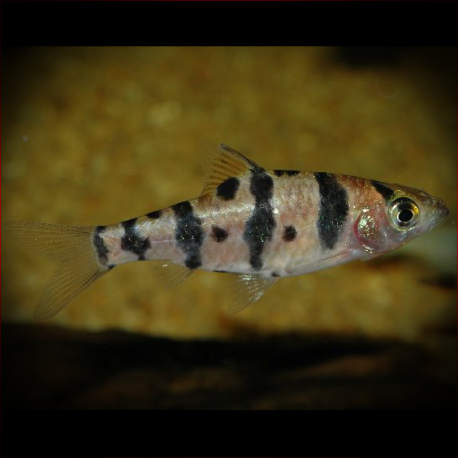More info
Datasheet
| Minimum Tank Size | 72 litres / 19.02 US gallons |
| Maximum Size | 5.5cm / 2.17inches |
| Temperature | 20°C / 68.00°F - 28°C / 82.40°F |
| Hardness | 1.01dgH / 18ppm - 10.03dgH / 179ppm |
| pH | 5.0-7.0 |
General Description
Desmopuntius Foerschi is a small fish also known as the "boomerang barb" or "Foersch's fire barb" and belongs to the family Cyprinidae. It can be distinguished by dark blotches between its vertical bars and a marking at the base of its dorsal fin. Typically reaching sizes of up to 5.5cm, this species was formerly classified in the Puntius genus until a reclassification by Kottelat in 2013.
Aquarium Setup
The ideal aquarium setup for Desmopuntius Foerschi involves keeping them in groups of at least 8-10 individuals with peaceful tankmates like similarly sized cyprinids, nemacheilid or cobitid loaches, and certain anabantoids. It thrives in a planted tank with soft, sandy substrate, driftwood, and dim lighting. Floating plants and dried leaf litter can also be added to recreate its natural habitat.
Behaviour
This fish is a schooling species by nature and keeping them in decent numbers can make them less skittish while enhancing their natural display. Males exhibit vibrant colors when competing for female attention. They should not be housed with aggressive or competitive species that might outcompete them for food.
Feeding and Diet
Desmopuntius Foerschi are primarily foragers, feeding on diatoms, algae, detritus, insects, worms, crustaceans, and zooplankton in the wild. In captivity, they readily accept small live and frozen foods like bloodworms, Daphnia, and Artemia, along with high-quality dried flakes and granules containing plant or algal content.
Reproduction & Dimorphism
Details about the reproduction of Desmopuntius Foerschi are currently unrecorded. Sexual dimorphism is observable in adults, with males being slightly smaller, slimmer, and displaying more intense coloration compared to females of similar age.
Habitat and Distribution
Native to the Indonesian provinces of Kalimantan Timur and Kalimantan Tengah on Borneo, this species is commonly found in peat swamps and blackwater streams with minimal dissolved minerals. Their habitat is shaded by vegetation, and water quality is influenced by the gradual release of tannins and organic acids from decaying plant material.

